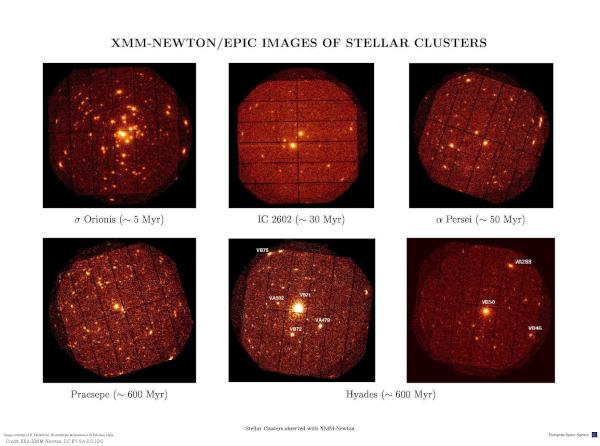Stellar Clusters observed with XMM-Newton

Minimum credit line: Image courtesy of R. Pallavicini, Osservatorio Astronomico di Palermo, Italy and ESA. (for details, see Conditions of Use).
Credit: ESA/XMM-Newton, CC BY-SA 3.0 IGO
The image above can be displayed at full size and may be downloaded by clicking the image above.
| About this Image |
|---|
The figure shows examples of XMM-Newton observations of open clusters obtained as part of the GTO program (PI: R. Pallavicini). The six panels show composite EPIC (MOS+pn) images of young open clusters of different ages, covering the age interval from a few million years to about 600 million years (the age of the Hyades).
Investigator(s): R. Pallavicini
| For More Information |
|---|
- Detailed description of this image
- For unfamiliar terms, visit the XMM-Newton Astronomical Glossary
| Instrument | EPIC | ||
| Observing Mode | Full Frame | ||
| Filter | N/A | ||
| Date of Observation | 2000-09-03 | ||
| Image size | 30.00 x 30.00 arcmin | ||
| Detailed Caption | The image on the top left is centered on the hot star sigma Orionis which is bright enough for simultaneous high-resolution RGS spectra. The cluster around sigma Orionis is extremely young, with an age comparable to that of Star Forming Regions (SFRs). IC 2602 and alpha Persei are typical examples of clusters intermediate in age between SFRs and the Pleiades (also observed by XMM-Newton) and thus provide an important link to understand the evolution of coronal activity from the pre-main sequence phase to the age of the Pleiades (about 100 million years). Praesepe (lower left panel) is a cluster of the same age as the Hyades, which was reported by ROSAT to be strongly underluminous in X-rays with respect to the latter cluster. The XMM-Newton observation revealed instead a good agreement between this XMM-Newton pointing of Praesepe and the Hyades suggesting that Praesepe may result from the merging of two clusters of different ages, with the older one largely outside of the XMM-Newton field of view. Finally, the two last panels show two different pointings at the Hyades cluster centered, respectively, on the Hyades giant VB 71 (Theta1 Tauri) and on the G dwarf VB 50. The latter two stars are sufficiently bright for simultaneous high-resolution spectra with RGS. Other weaker Hyades members present in the field are also marked in the figure. In all the above XMM-Newton exposures (of about 50 ksec each), a large number of sources (typically between 100 and 200) have been detected, a significant number of which belong to the clusters. Comparison with optical catalogues allows determination of the X-ray luminosity distribution for stars of different spectral types, while comparison of clusters of different ages, and with rotation rates derived from optical observations, allows determination of the evolution of coronal activity with rotation and age. The temperature structure and chemical abundances of the emitting coronae can be determined for the brightest sources from EPIC and RGS spectra. For bright sources detected also by previous X-ray satellites it is possible to investigate time variability over time scales of years, possibly associated to activity cycles. Short term variability (hours) in the form of stellar flares has also been detected during some of the XMM-Newton exposures. Note that the above clusters are all within a distance of a few hundred parsec and are much more extended, except the one around sigma Orionis, than the XMM-Newton FOV. Different pointings at these clusters as well as observations of other clusters of different age will allow a better understanding of the properties of individual clusters and of the evolution of coronal activity with age, including the crucial issue whether a cluster of a given age can be considered as representative of all clusters of the same age (an assumption which has been challanged by recent optical and X-ray observations). Some of these observations, which include clusters intermediate in age between the Pleiades and the Hyades as well as clusters older than the Hyades, have already been performed or are planned with XMM-Newton. For further (technical info) see individual gallery entries of these stellar clusters. | ||
| Alternate Resolutions | (Help) |
|---|
This image is available in the following downloadable versions: Higher resolution versions of this image may be available, please contact the XMM-Newton HelpDesk.
Search the Image Gallery
To search the Image Gallery for a particular object, fill in the object name in the box below and click the Submit button.To search the Image Gallery for other images, fill in any of the fields below and click the Submit button.
For more search options, please use our Advanced Search form.